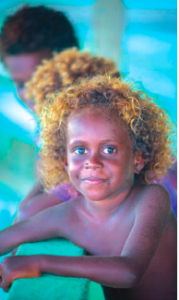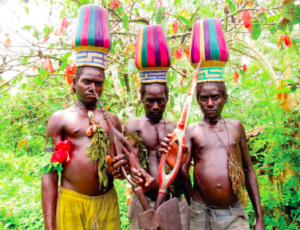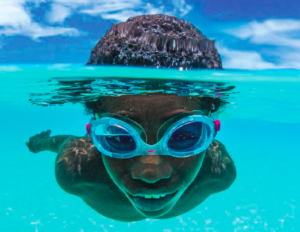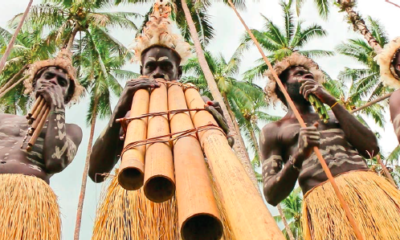A recently launched plan to develop Bougainville as a tourism hub has put the spotlight on the island. Tom Besley provides an insider’s guide for intrepid travellers.
 As I approach the summit camp of Mount Balbi, I can hear my guides in the distance, cracking sticks for the fire. I’m surprised also to hear the sound of quick feet behind me. I turn around and watch two barefoot boys overtake me, whistling as they amble up the steep final stages of the track. They smile and walk on without stopping. Some minutes pass and then there’s laughter. I’m guessing the boys have reached the fire and reported on my state.
As I approach the summit camp of Mount Balbi, I can hear my guides in the distance, cracking sticks for the fire. I’m surprised also to hear the sound of quick feet behind me. I turn around and watch two barefoot boys overtake me, whistling as they amble up the steep final stages of the track. They smile and walk on without stopping. Some minutes pass and then there’s laughter. I’m guessing the boys have reached the fire and reported on my state.
When I arrive there is water boiling for rice and tea, and the guys are settled in for the night under a tarpaulin. I pitch my tent and sink into the soft mossy bed beneath me, listening to their jokes as the fire hisses. Mount Balbi is a dormant volcano at the centre of Bougainville Island, opened up to visitors by Rotokas Ecotourism in 2011.
Founded by two friends, Pedro Uravutu and Junias Repiriri, from villages on different sides of the mountain range, this initiative stretches way beyond tourism. They are committed to protecting the landscape and working in harmony with the villagers along the trekking routes.
The two friends have achieved this by tirelessly engaging landowners along the way in conservation programs and including them in decision making about how the trails should be run. This means everyone is happy to see you and it makes staying in the Rotokas region an unmissable experience. Their base is on the main road, where they have small bungalows next to a lazy river. Guests stay the night before riding up a tributary road to where the trail begins.
If you are lucky, you might catch a glimpse of the secretive Upe, who live in this part of Bougainville. Upe is the name given to young men from Rotokas, who come of age during a period of focused schooling, where they learn how to live from their land and how to respect it. Their customary hat – called the Upe – adorns the Bougainville flag.
 To reach the summit of Mount Balbi, I pass enormous sulphur yellow vents, spewing thick white smoke that blows over deep canyons of stark grey scree.
To reach the summit of Mount Balbi, I pass enormous sulphur yellow vents, spewing thick white smoke that blows over deep canyons of stark grey scree.
There is a lake in one caldera, which I pass along a ridge that rises gently. At the top, the view on both sides stretches down to the sea. I can see strings of little islands that hover along Bougainville’s coastline.
Many of the islands are inhabited and make excellent places to relax after trekking. Most popular is Pok Pok Island, which has a secluded beachfront guesthouse that faces east into the Pacific Ocean. I choose Teop Island.
Although Teop does not have a guesthouse, like most areas in Bougainville there are always places to stay. I meet Ben Racine, the chief of the island, who has arranged a traditional greeting, which involves my feet being washed and lots of shaking of hands. As we walk through the island’s immaculately kept flower gardens, he tells me that our food is being cooked in a mumu .
He shows me a low mound, which is covered in large green leaves. The cooks peel back the leaves to show a pile of hot stones, which surround about 40 perfectly cooked yams. They are laid out on a table, with freshly caught tuna, cooked greens, potatoes, cooked bananas in coconut milk and big steaming piles of noodles.
As we eat, the island’s string band plays a cheerful set of Pacific songs as a team of dancers in grass skirts shuffles across the sand. The whole village has turned out and we share food as dusk falls. The next morning, I’m invited out on a dugout canoe for some fishing. It doesn’t take long to find my balance, and soon we are gliding along the edge of Teop Island, waving at villagers having their morning wash
As a newly designated hub for tourism, Bougainville is just beginning to reveal its potential, and Teop Island is an excellent example of a village stay that can be organised with relative ease.
 It is always good to phone ahead. The easiest way to arrange a trip is to call in at New Dawn FM in Buka town, the capital of Bougainville. New Dawn is run by Aloysius Laukai, who has 30 years’ experience in broadcasting in Bougainville. As a result, he has the telephone numbers of all of the key people on the island. Drop by to enjoy a cold drink and their Wi-Fi hotspot, and Laukai will help you plan your adventure.
It is always good to phone ahead. The easiest way to arrange a trip is to call in at New Dawn FM in Buka town, the capital of Bougainville. New Dawn is run by Aloysius Laukai, who has 30 years’ experience in broadcasting in Bougainville. As a result, he has the telephone numbers of all of the key people on the island. Drop by to enjoy a cold drink and their Wi-Fi hotspot, and Laukai will help you plan your adventure.
One of his reporters, Laurence, is from Teop and will help you contact the islanders to arrange your trip. For those who prefer to book in advance, there is a village stay at Topinang in the mountains in central Bougainville.
I meet Bosco, who set up the village stay, in Arawa town, and he drives me through a torrential downpour to a cluster of traditionally constructed houses, which sit on the banks of a river. I am welcomed with baskets of fruit, freshly baked bread and a meal of succulent aromatic squash, cooked inside a length of bamboo, a process that steams food to perfection. To my surprise the lights are on.
It turns out that the river drives a small hydro generator, and I enjoy uninterrupted power for the whole weekend. One day I make a short hike up into the mountains overlooking Arawa, visiting a local craftsman along the way. An accomplished carver, Chris is also a master marksman who shows me how to fire a bow and arrow in a matter of minutes. I let an arrow fly out into the thick forest that surrounds us and imagine what it would be like to join a hunt.
Later that night, some boys pass through the hamlet with a clutch of flying foxes slung over their shoulder. I ask if they used arrows and they show me their slingshots. I’m grateful that they don’t offer to share their dinner with me.
The next day I am invited to a feast, which is attended by people from the surrounding villages. Enormous bamboo structures are built to hold food harvested especially for the occasion. People are singing and dancing, everyone is laughing and sharing food.
Bosco offers me a freshly split coconut and tells me that no one on Bougainville goes hungry because the land is so rich. There is so much laughter and happiness in this valley. I leave knowing I have witnessed something I will never forget.
Tourism on Bougainville is expected to go from strength to strength because of the region’s historic respect for the natural world.
The Bougainville government recently launched a tourism initiative, which will develop Buka town as a regional tourism hub. The Solomon Seas Tourism Zone Initiative Committee has also been set up to help develop other potential tourism sites in Bougainville, Solomon Islands, Vanuatu and Fiji.
 Over the next decade, development will bring improved infrastructure, but the intrepid traveller needn’t wait to make a trip. From pristine island beaches to epic mountain treks, from bamboo bands to bamboo cuisine, the region is ready to welcome visitors who want to enjoy its natural beauty.
Over the next decade, development will bring improved infrastructure, but the intrepid traveller needn’t wait to make a trip. From pristine island beaches to epic mountain treks, from bamboo bands to bamboo cuisine, the region is ready to welcome visitors who want to enjoy its natural beauty.
Tobias Kulang, the national minister for tourism, arts and culture, recently said that Bougainville has the potential to become a premier tourism destination. “This place can be defined as the last frontier in terms of tourism in Papua New Guinea and in the Pacific,” he told EMTV. “Bougainville is the last discovery; it has been hidden away from the rest of world and now we are about to explore the (tourism) products.”

